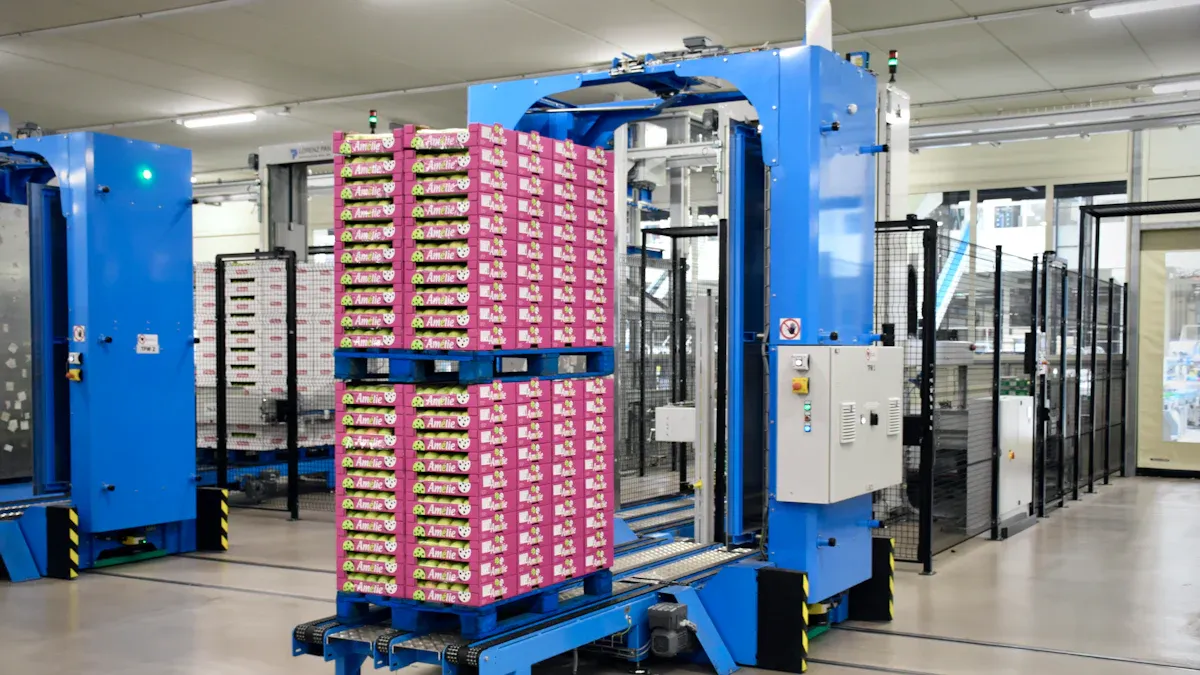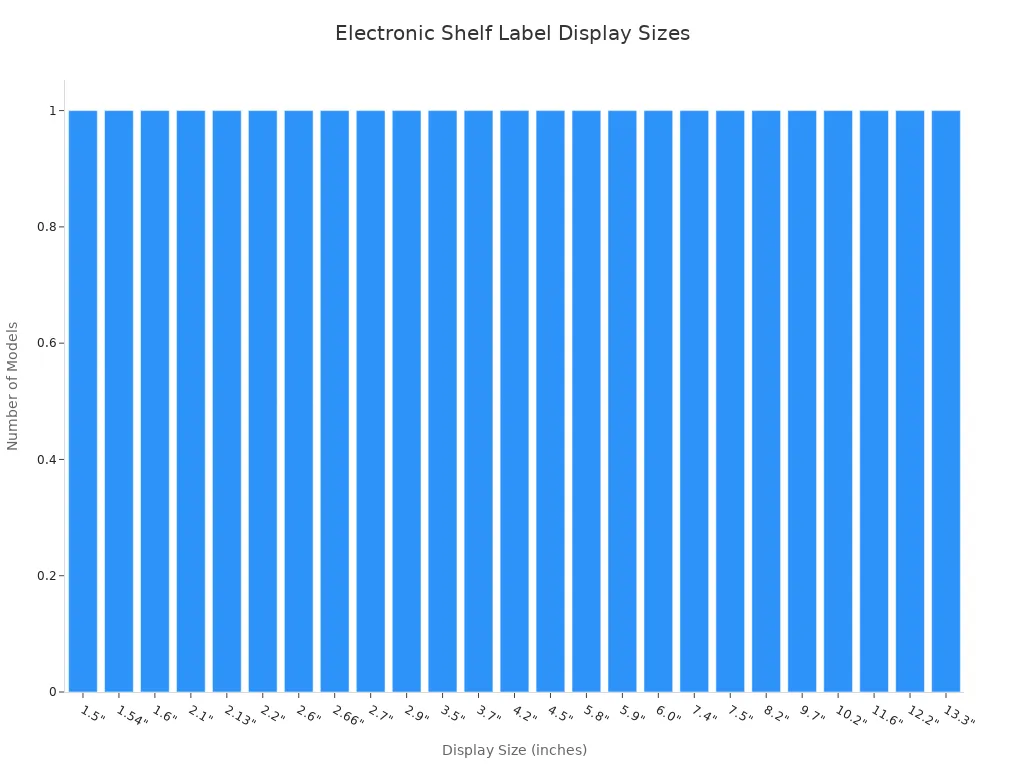
When you choose an electronic shelf label manufacturer, you face several key considerations. Over 20,000 retail stores worldwide have implemented Electronic Shelf Labels, showing the growing demand for reliable solutions. You may encounter installation complexity, system integration with ESL Gateway AP, and budget constraints when evaluating ESL Price Tag options. The table below highlights common challenges:
| Challenge Type | Description |
|---|---|
| Installation Complexity | Minimizing disruption during installation and daily operations. |
| System Integration | Ensuring compatibility with POS and inventory management systems. |
| Budget Constraints | Balancing initial costs and ongoing maintenance within Esl Retail budgets. |
Choose an Electronic Shelf Label Manufacturer for Software Features and Integration
System Compatibility
When you evaluate electronic shelf labeling solutions, you need to ensure seamless compatibility with your existing systems. Most retailers request integration with their POS and inventory management platforms. This integration allows you to synchronize pricing and product information across all channels. You should look for manufacturers who offer cloud-based management software and API access, which enable you to manage electronic shelf labels from any location.
| Feature | Description |
|---|---|
| Critical POS Integration | Integrate ESLs directly with your POS for unified, omnichannel pricing updates. |
| Cloud-Based Management Software | Manage your ESLs from anywhere with a user-friendly cloud platform for remote monitoring. |
| Key Software Integrations | Effortlessly integrate with current systems for a fully connected pricing solution. |
Tip: Ask your vendor if their system supports both cloud and on-premise deployments. This flexibility helps you adapt to future technology changes.
You should also consider hardware limitations and the scalability of the solution. Reliable manufacturers provide highly compatible devices that work with a wide range of retail management software. They prioritize user-friendliness and offer customization options to fit your store’s needs.
Security and Data Protection
Protecting sensitive business data is essential when you choose an electronic shelf label manufacturer. Leading manufacturers implement advanced security protocols, such as proprietary 2.4G private protocols and robust encryption methods. These measures safeguard your pricing and inventory data from unauthorized access and cyber threats.
| Security Protocol | Description |
|---|---|
| Proprietary Encryption | Uses private protocols to protect sensitive business data from unauthorized access. |
| Secure Transmission | Encrypts data during transmission and storage to minimize the risk of cyberattacks. |
| Advanced Security | Prevents unauthorized access, ensuring secure integration and operation. |
Manufacturers also address data privacy regulations like GDPR and CCPA. You benefit from consent management systems, anonymization techniques, and secure data lakes. These practices help you comply with evolving data governance requirements and protect customer information.
- Consent management for regulatory compliance
- Anonymization to protect user data
- Secure data lakes for data security
- Data governance adaptation for new regulations
Remote Management and Data Analytics
Remote management capabilities allow you to control electronic shelf labels across multiple locations. You can update prices and product information instantly, reducing manual labor and errors. User-friendly software makes it easy for you to manage shelf labels and monitor system performance.
| Feature | Description |
|---|---|
| Real-time updates | Enables retailers to update prices and information instantly across multiple locations. |
| System Integration | Allows ESLs to communicate with other devices, creating a seamless network of data. |
| User-friendly software | Designed for ease of use, enabling quick updates and management of shelf labels. |
Data analytics play a vital role in optimizing store operations. AI-driven analytics collect and analyze in-store data, guiding your business strategies. You gain real-time visibility into pricing and stock levels, which helps you make informed decisions and measure ROI on key performance indicators.
- Multicolor ESLs enable remote price changes
- Computer vision technology detects out-of-stocks in real time
- Store analytics measure ROI on strategic KPIs
Note: Advanced analytics tools help you track promotional effectiveness and inventory trends, giving you a competitive edge.
When you choose an electronic shelf label manufacturer, prioritize software features that support integration, security, and remote management. These capabilities streamline your operations and enhance your store’s performance.
Choose an Electronic Shelf Label Manufacturer for Hardware Quality and Reliability

Wireless Technology Standards
When you evaluate electronic shelf labeling solutions, you should pay close attention to the wireless technology standards they use. Reliable communication forms the backbone of any ESL technology. Most leading systems rely on the following:
- Bluetooth technology
- NFC
- Integrated IoT solutions
Bluetooth Low Energy (LE) stands out for its scalability and efficiency. This standard allows you to connect many devices while keeping energy consumption low. Stable wireless networks reduce the risk of signal interference and system congestion. You can improve reliability by choosing systems that use dedicated RF frequencies, deploy multiple base stations, and monitor connectivity regularly. The adoption of Bluetooth as a global standard also means you can source components from different vendors with confidence, ensuring compatibility and reducing barriers to adoption.
Battery Life and Maintenance
Battery life plays a crucial role in the total cost of ownership. Most electronic shelf labels from top manufacturers offer an average battery life of five to ten years. You can further extend this lifespan by using light-powered labels with indoor solar cells. These labels allow for more frequent updates without draining the battery, which reduces maintenance needs and saves both time and money.
To maximize battery performance, consider these best practices:
- Arrange update frequency based on actual needs.
- Regularly check battery status and replace batteries promptly.
- Optimize display content with simple text and graphics.
- Select labels with efficient battery management systems.
You can also power off labels when the store is closed, use LED features only when necessary, and maintain recommended operating temperatures. Scheduling price updates instead of random changes helps conserve battery life.
Durability and Build Quality
Durability ensures your investment in ESL technology pays off over time. You should look for labels with robust casings that resist impacts, dust, and moisture. High-quality materials and solid construction protect the internal electronics and extend the product’s lifespan. Reliable hardware reduces the risk of failures and minimizes downtime, keeping your store operations smooth.
Tip: Always ask manufacturers about their product testing standards and certifications. This step helps you verify the durability and reliability of their hardware.
When you choose an electronic shelf label manufacturer, prioritize hardware that meets high standards for wireless connectivity, battery longevity, and physical durability. These factors ensure your electronic shelf labeling system remains reliable and cost-effective for years.
Choose an Electronic Shelf Label Manufacturer for Customer Support and Service
Responsiveness and Availability
When you choose an electronic shelf label manufacturer, you need a partner who responds quickly to your needs. Fast response times help you resolve technical issues and minimize downtime in your store. Leading manufacturers offer dedicated support teams that handle installation, maintenance, and troubleshooting. You benefit from comprehensive support throughout the product lifecycle, which maximizes the value of your investment. Reliable after-sales service sets top vendors apart and ensures your electronic shelf labeling system runs smoothly.
Tip: Ask potential vendors about their average response times and support channels. Quick access to help can make a significant difference during peak business hours.
Training and Onboarding
Proper training and onboarding help your staff use electronic shelf labeling systems efficiently. Top manufacturers provide a range of resources to support your team. You can access online learning centers, attend in-person sessions, or explore advanced training modules. These resources ensure your employees understand both the hardware and software, reducing errors and boosting productivity.
| Training Resource | Link |
|---|---|
| Online Learning Center | Online Learning Center |
| CATAPULT Fundamentals | CATAPULT Fundamentals |
| Advanced CAT-U | Advanced CAT-U |
| Onsite CAT-U | Onsite CAT-U |
You should choose a manufacturer that offers flexible training options to match your store’s needs.
Warranty and After-Sales Service
Warranty terms and after-sales service policies vary among manufacturers. A strong warranty protects you from defects and manufacturing issues. Most vendors offer a 12-month warranty covering defective materials, provided you have proof of purchase. The warranty usually excludes accessories and damage from misuse or improper installation. Repair or replacement services often last for the original warranty period or 28 days, whichever is longer.
| Aspect | Details |
|---|---|
| Warranty Duration | 12 months from product receipt |
| Coverage | Defective material and manufacturing defaults (excluding accessories) |
| Validity Conditions | Requires invoice or sales receipt from an authorized seller |
| Repair/Replacement | Repair or replacement at manufacturer’s discretion; coverage lasts for original period or 28 days |
| Transferability | Not transferable |
| Exclusions | No coverage for misuse, negligence, or improper installation |
| Legal Applicability | Subject to laws of country of purchase |
After-sales service includes more than just warranty coverage. You receive guidance on installation, maintenance, and troubleshooting. Comprehensive support enhances your overall experience and helps you get the most from your electronic shelf labeling investment.
Choose an Electronic Shelf Label Manufacturer for Display Options and Customization

Display Size and Clarity
You need to select display sizes that fit your store’s shelving and product types. Leading manufacturers offer a wide range of display sizes, from compact tags for small items to large panels for promotional displays. The table below shows common display sizes available:
| Size |
|---|
| 1.5″ |
| 1.54″ |
| 1.6″ |
| 2.1″ |
| 2.13″ |
| 2.2″ |
| 2.6″ |
| 2.66″ |
| 2.7″ |
| 2.9″ |
| 3.5″ |
| 3.7″ |
| 4.2″ |
| 4.5″ |
| 5.8″ |
| 5.9″ |
| 6.0″ |
| 7.4″ |
| 7.5″ |
| 8.2″ |
| 9.7″ |
| 10.2″ |
| 11.6″ |
| 12.2″ |
| 13.3″ |

Clarity matters as much as size. You want high-contrast, bold fonts for easy reading. Anti-glare coatings help reduce reflections from store lighting, so shoppers can read information from any angle. E-paper displays provide sharp, clear text that stays visible even in bright light, reducing eye strain for both staff and customers.
- High contrast and bold fonts improve legibility.
- Anti-glare coatings ensure clear readability.
- E-paper displays offer sharp text in all lighting conditions.
Customization Features
Customization helps you align digital price tags with your brand and store needs. You can choose from a variety of color options, from monochrome to full-color displays. Flexible layouts let you adjust fonts, graphics, and information to match your brand identity. Interactive features, such as NFC, allow customers to reserve products or access dynamic pricing.
| Customization Feature | Description |
|---|---|
| Color Options | Monochrome to full-color displays for pricing and promotions. |
| Layout Flexibility | Tailor layouts, fonts, and graphics to fit your brand. |
| Interactive Features | NFC for reservations and dynamic pricing. |
Manufacturers also offer customizable e-paper displays for highlighting prices or advertisements. You can update content in real time, run promotions, and integrate with your POS system for seamless operation. Centralized administration gives you full control over all displays, improving customer satisfaction and loyalty.
| Feature | Description |
|---|---|
| Customizable e-paper display | Highlight prices, ads, and information. |
| Content flexibility | Update displayed information as needed. |
| Real-time promotions | Adjust promotions and pricing instantly. |
| Integration with POS systems | Seamless operation with retail systems. |
| Centralized administration | Full visibility and control over displays. |
| Enhances customer loyalty and satisfaction | Improves shopping experience. |
Energy Efficiency
Energy efficiency impacts your store’s costs and sustainability goals. Top electronic shelf labels use advanced e-paper technology, wireless connectivity, and smart power management. Some models operate for up to ten years on a single battery. Pricer AB and other leaders focus on energy-efficient solutions that support greener retail environments.
- E-paper technology uses power only during updates.
- Wireless connectivity and power management extend battery life.
- Some digital price tags last up to a decade without battery changes.
“E-Ink Labels: Consume power only when the display updates, making them incredibly energy-efficient for static pricing.”
You benefit from lower utility expenses and reduced maintenance. The durable design of digital price tags also minimizes recurring costs, helping you maximize your investment.
Choose an Electronic Shelf Label Manufacturer by Evaluating and Comparing Vendors
Checklist of Questions to Ask
When you evaluate vendors, you need to ask targeted questions that reveal their strengths and limitations. This approach helps you make informed decisions and avoid costly mistakes. Consider the following checklist:
- What use cases can optimize employee experience in your store?
- How does the system scale as your business grows?
- Can the platform adapt to future needs and technology changes?
- Is the solution compatible with your existing systems?
- What are the ROI and total cost of ownership calculations?
- Which regulations apply to electronic shelf labeling in your region?
- What security protocols protect your data?
- What label sizes and color features are available?
- Can the system handle complex messages and promotions?
- What is the expected battery life for digital price tags?
Tip: Use this checklist during vendor meetings to compare offerings side by side.
References and Case Studies
You should request references and review case studies to understand how vendors perform in real-world scenarios. For example, an electronic shelf labeling company partnered with RGIS to reinstall ESLs overnight, allowing retailers to operate without disruption. Autobarn, a leading automotive retailer in Australia, improved price accuracy and staff productivity by integrating ESLs with their POS system. Store Intelligence enabled real-time price updates across multiple locations, helping retailers respond quickly to market changes. Office Shoes adopted Hanshow’s ESL technology to streamline operations and enhance customer service by updating digital price tags instantly.
These examples show how successful implementation can improve efficiency, accuracy, and customer satisfaction. You gain valuable insights by learning from other retailers’ experiences.
Pricing and Total Cost of Ownership
Pricing models for digital price tags depend on regional trends, technology, and market dynamics. In Europe, sustainability mandates and digital transformation drive adoption, while Asia-Pacific retailers focus on interactive features. E-paper displays reduce operational costs because they use power only during updates. Manufacturers also manage costs by investing in tariff-exempt regions and optimizing components. These strategies help you maintain price competitiveness and maximize the total cost of ownership.
When you choose an electronic shelf label manufacturer, you should compare pricing structures, evaluate long-term savings, and consider how digital price tags impact your store’s bottom line.
Choosing the right electronic shelf label manufacturer shapes your store’s efficiency and long-term success. You gain better resource management, eco-friendly savings, error reduction, and regulation compliance by selecting a high-quality partner:
| Benefit | Description |
|---|---|
| Better Resource Management | Reduces the need for manual price updates, allowing staff to focus on more critical tasks. |
| Eco-Friendly Savings | Decreases paper usage, leading to cost savings and environmental benefits. |
| Error Reduction | Minimizes human errors in pricing, ensuring accuracy and consistency in pricing. |
| Regulation Compliance | Helps avoid fines by ensuring compliance with pricing regulations, reducing potential costs. |
- Ongoing maintenance costs support system longevity.
- You save significantly by reducing labor and eliminating paper label expenses.
Careful comparison helps you streamline operations, enhance customer experience, and maximize your investment.
FAQ
What is the typical lifespan of an electronic shelf label?
Most electronic shelf labels last five to ten years. You can extend their lifespan by choosing models with energy-efficient e-paper displays and following recommended maintenance practices.
Can you update prices on all labels at once?
Yes. You can update prices across all labels instantly using centralized management software. This feature saves time and reduces manual errors.
Do electronic shelf labels work with any POS system?
Many electronic shelf labels integrate with popular POS systems. You should confirm compatibility with your vendor before purchase to ensure seamless operation.
How do you maintain electronic shelf labels?
You should check battery status regularly, clean the display surfaces, and follow the manufacturer’s maintenance guidelines. Proper care helps you maximize performance and longevity.
Are electronic shelf labels secure against hacking?
Leading manufacturers use encryption and secure communication protocols. You should ask your vendor about their security measures to protect your store’s data.


